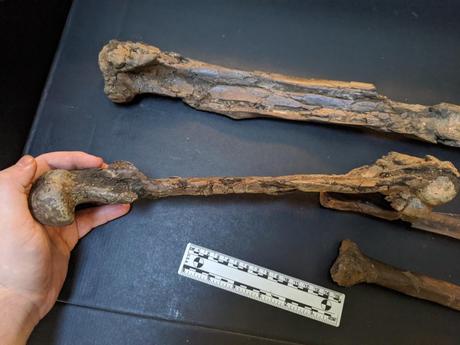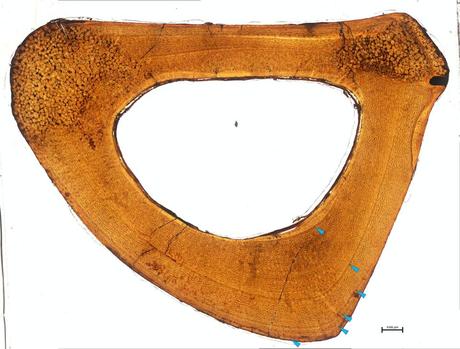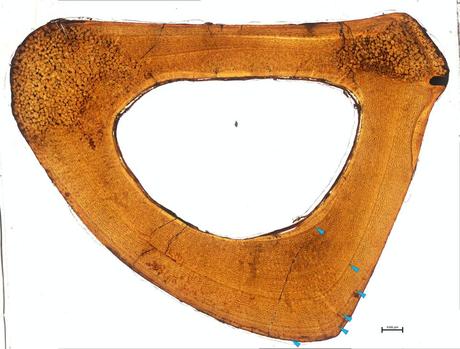Were dinosaurs already on their way out when an asteroid hit Earth 66 million years ago, ending the Cretaceous Period, the geological era that began about 145 million years ago? It’s a question that has plagued paleontologists like us for more than forty years.
In the late 1970s, debate began over whether dinosaurs were at their peak or in decline before their great extinction. Scientists noted at the time that although dinosaur diversity appeared to have increased during the geological stage that stretched from 83.6 million to 71.2 million years ago, the number of species on the scene appeared to decrease over the last few million years of the Cretaceous. Some researchers have interpreted this pattern to mean that the asteroid that hit the Gulf of Mexico was simply the final blow to an already vulnerable group of animals.
However, others have argued that what appears to be a decline in dinosaur diversity may be an artifact of how difficult it is to count them accurately. Fossil formations can more or less preserve different dinosaurs, depending on factors such as their preferred environment and how easily their bodies fossilized there. The accessibility of different outcrops could influence the types of fossils researchers have found so far. These biases pose a problem because paleontologists must rely on fossils to provide a conclusive answer to the question of how healthy dinosaur populations were when the asteroid hit.
What really happened to dinosaur diversity at that crucial moment? Discovery, identification and description of new dinosaurs provide vital clues. This is where our work comes into play. Close examination of what we thought was a juvenile specimen of an already known dinosaur species from this period revealed that it was actually part of an adult specimen of an entirely new species.
Our work focusing on the life stage of our specimen shows that dinosaur diversity may not have declined before the asteroid hit, but rather that there are additional species from this period that have yet to be discovered – possibly even through reclassification of fossils that are already in museum collections. .

Kyle Atkins-Weltman holds the femur of the new dinosaur as it was received, with the other fossils in the background. Kyle Atkins Weltman
Clues in the bones of a bird-like dinosaur
Our new study focused on four hindlimb bones: a femur, a tibia and two metatarsals. They were excavated in South Dakota, in the rocks of the Hell Creek Formation, and date from the last 2 million years of the Cretaceous period.
When we first examined the bones, we identified them as belonging to a family of dinosaurs known as the caenagnathids – a group of bird-like dinosaurs with toothless beaks, long legs and short tails. Direct fossil and inferred evidence indicates that these dinosaurs were covered in complex feathers, much like modern birds.
The only known species of caenagnathid from this time and region was Anzu, also known as the ‘chicken from hell’. Covered in feathers and sporting wings and a toothless beak, Anzu was between about 450 and 750 pounds (200 and 340 kilograms). However, despite its fearsome nickname, its diet is a matter of debate. It was probably an omnivore, eating both plant matter and small animals.
Because our specimen was significantly smaller than Anzu, we just assumed it was a juvenile. We noted the anatomical differences we noticed in its juvenile status and smaller size – and concluded that the animal would have changed if it had continued to grow. Anzu specimens are rare and no definitive juveniles have been published in the scientific literature, so we were excited to possibly learn more about how it grew and changed during its life by looking inside its bones.
Similar to the rings of a tree, rings of bone registers are called lines of arrested growth. Each year line represents part of a year when the animal’s growth slowed. They told us how old this animal was and how fast or slow it grew.
We cut the center of three bones so that we could examine the internal anatomy of the cross-sections microscopically. What we saw completely uprooted our initial assumptions.


Blue-green markings indicate lines of arrested growth on the cross-section of fossilized bone. On the outside of the bone, the lines are much closer together, indicating less growth per year. Researchers counted exactly six lines, meaning this animal was between 6 and 7 years old when it died. Holly Woodward
In a juvenile we would expect the lines of arrested growth in the bone to be widely spaced, indicating rapid growth, with even spacing between the lines from the inside to the outside surface of the bone. Here we saw that the later lines were becoming closer together, indicating that this animal’s growth had slowed and had almost reached adult size.
This was not a juvenile. Instead, it was an adult of an entirely new species, which we named Eoneophron infernalis. The name means ‘pharaoh’s chicken from hell’, referring to the nickname of its larger cousin Anzu. Features unique to this species include ankle bones fused to the tibia, and a well-developed ridge on one of the foot bones. These were not characteristics of a young one Anzu would outgrow, but rather unique aspects of the smaller Eoneofron.
Expansion of the caenagnathid family tree
With this new evidence, we began making thorough comparisons with other members of the family to determine where Eoneophron infernalis fit within the group.
It also inspired us to re-examine other bones previously thought to be so Anzu, because we now knew that more caenagnathid dinosaurs lived in western North America at that time. One specimen, a partial foot bone smaller than our new specimen, appeared to differ from both Anzu And Eoneofron. Where once there was one ‘chicken from hell’, there were now two, and evidence of a third: one big one (Anzu), weighing as much as a grizzly bear, one medium (Eoneofron), human in weight, and a small yet nameless, similar in size to a German Shepherd.
Eoneophron infernalis and the smaller unnamed species now join the larger ones Anzu as late Cretaceous caenagnathid dinosaurs from the Hell Creek region. Zubin Erik Dutta
If we compare Hell Creek with older fossil formations such as the famous Dinosaur Park Formation of Alberta, which is home to dinosaurs that lived between 76.5 million and 74.4 million years ago, we find not only the same number of caenagnathid species, but also the same size classes . There we have CaenagnathusSimilar to Anzu, ChirostenotenSimilar to EoneofronAnd Citipes, similar to the third species for which we found evidence. These parallels in both species number and relative size provide compelling evidence that caenagnathids remained stable throughout the latter part of the Cretaceous.
Our new discovery suggests that this dinosaur group did not decline in diversity at the very end of the Cretaceous period. These fossils show that new species still need to be discovered, and support the idea that at least part of the pattern of declining diversity is the result of sampling and conservation biases.
Have big dinosaurs gone extinct in the way that one Hemingway character joked about going bankrupt: “gradually, and then suddenly”? While many questions remain open in this extinction debate, Eoneofron adds evidence that caenagnathids were doing quite well for themselves before the asteroid ruined everything.
This article is republished from The Conversation, a nonprofit, independent news organization providing facts and analysis to help you understand our complex world.
It was written by: Kyle Atkins-Weltman, Oklahoma State University and Eric Snively, Oklahoma State University.
Read more:
The authors do not work for, consult with, own shares in, or receive funding from any company or organization that would benefit from this article, and have disclosed no relevant affiliations beyond their academic appointment.
